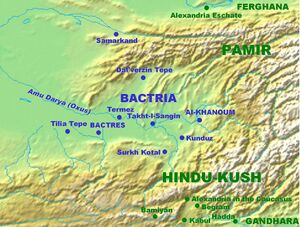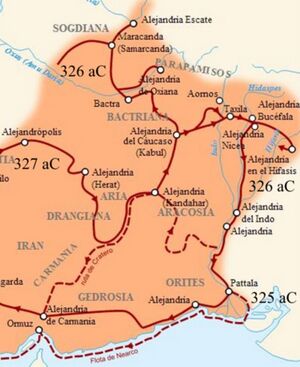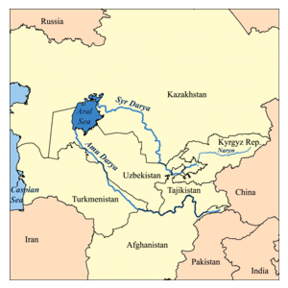Samarkand
| Author:Laxman Burdak, IFS (Retd.) |



Samarkand (समरक़न्द) is the second-largest city in Uzbekistan and the capital of Samarqand Province. The city is most noted for its central position on the Silk Road between China and the West.
Variants of name
- Maracanda (Anabasis by Arrian, p. 202, 210, 213, 215, 235, 236.)
- Samarcand (Anabasis by Arrian, p. 202.)
- Samarkand समरकन्द, दक्षिण रूस, (AS, p.936)
- Samarkanda
- Marcand
- Maracanda (Arrian, Anab. 3.30)
- Marakanda (मारकंड) = Samarkand (AS, p.736)
- Samarkan
Origin of name
The Samarkand city was known by an abbreviated name of Marakanda when Alexander the Great took it in 332 BC. At that time Maracanda was the capital of the land of the Sogdianians.[1] There are various theories of how Marakanda evolved into Samarkanda/Samarkan.
Marakanda (मारकंड) is name of Samarkand in Sanskrit. (AS, p.736)
One derives the name from the Old Persian asmara, "stone", "rock", and Sogdian kand, "fort", "town".[2]
मारकंड
मारकंड (AS, p.736) समरकंद का संस्कृत नाम है. (दे. नं. ला. डे).[3]
समरकन्द
समरकन्द (AS, p.936), दक्षिण रूस में स्थित प्राचीन साहित्य में उल्लिखित मारकंद है.[4]
जाट इतिहास
समरक़न्द - समरक़न्द के निवासी समरक़न्दी कहलाते हैं। समरक़न्दी अपभ्रंश है सम्बरखण्डी का। तात्पर्य है महाराणी उषा के पिता सम्बासुर के उत्तराधिकारियों से। इसीलिए समरक़न्द के नजदीक खीवा और बुखारा के बीच रहने वाले लोग उषबेक कहलाते हैं। उषबेक अपभ्रंश है उषबेंक का। तात्पर्य है श्रीमती महाराणी उषा के पितृवंशियों से (टॉड राजस्थान) (पृ० 20)। जिस स्थान पर श्रीकृष्ण जी का सम्बरासुर से युद्ध हुआ था, समरकन्द कहलाता है।
यह वही सम्बरासुर है जिसकी राजकन्या उषा का श्रीकृष्णपुत्र अनिरुद्ध के साथ स्वयंवर हुआ था। वह स्थान जहां पर सम्बरासुर की माता ‘कोटरा’ रहती थी, ‘कोक़न्द’ कहलाता है, जो कि
जाट वीरों का इतिहास: दलीप सिंह अहलावत, पृष्ठान्त-334
अपभ्रंश और लघुरूप है ‘कोटरा खण्ड’ का (देखो श्रीमद् भागवत)। वह स्थान जहां पर असुर लोगों ने पहली आबादी स्वीकार की थी, ‘निशांपुर’ कहलाता है जो कि अपभ्रंश है ‘निशापुर’ का। जैसे - निशाचर या असुरों का देश। (पृ० 44-45)।
डॉ रणजीतसिंह[5] लिखते हैं....जाटों के विस्तार की पुष्टि एंटीक्विटी ऑफ जाट रेस के लेखक उजागर सिंह महल के विचारों से भी होती है। महल महोदय अपनी पुस्तक में लिखते हैं - "मैं अब विशालतम जाट साम्राज्य का वर्णन करता हूं जो कि मात्र भौगोलिक सीमाओं के कारण ही बड़ा नहीं था, अपितु इजिप्ट और असीरिया के साम्राज्यों से भी बड़ा था। यह स्मरण रखना चाहिए कि पर्शियन साम्राज्य जाट साम्राज्य की देन है और पर्शियन राजाओं में जाट रक्त विद्यमान है। जाटों के इस साम्राज्य को मेड़ा साम्राज्य कहते हैं[6] महल के मतानुसार जाटों ने रोमन साम्राज्य, स्पेन और ब्रिटेन तक को जीता था [7] [पृष्ठ.5]: इससे आगे वे लिखते हैं ....:"यूरोप की डेन्यूब नदी जाटों के पुरातात्विक इतिहास की दृष्टि से बड़ी महत्वपूर्ण है। इस नदी के दोनों किनारों पर जाट ही निवास करते थे। डेन्यूब नदी जाटों से इतनी संबंधित है कि वह उनके स्वप्नों में भी आती है।"
सिकंदर महान ने अपने एशिया आक्रमण के समय सोगड़ियाना (तुर्किस्तान) पर आक्रमण किया था। उस समय सोगड़ियाना की राजधानी समरकंद थी। उजागर सिंह के विचार अनुसार यह प्रदेश उस समय जाटों के अधीन था जो कि पंजाब के जाटों के बहुत दूर के पूर्वज थे।
जाटों का तैमूर से युद्ध
दलीप सिंह अहलावत[8] ने लिखा है कि मध्यएशिया में जाटों को परास्त करके तैमूर ने अपनी राजधानी समरकन्द में स्थापित की। उसने अपनी विशाल सेना से तुर्किस्तान, फारस, अफगानिस्तान आदि देशों को जीतकर भारत पर आक्रमण करने का निश्चय किया जो उस समय बड़ी अव्यवस्थित दशा में था। दिल्ली सल्तनत पर तुगलक वंश का अन्तिम बादशाह महमूद तुगलक था जो कि एक निर्बल शासक था। भारत में फैली हुई अराजकता को दबाने में वह असफल था। इस दशा से लाभ उठाते हुए तैमूर ने भारत पर आक्रमण कर दिया।
तैमूर ने सबसे पहले अपने पौत्र पीर मुहम्मद को सेना के अग्रभाग का सेनापति बनाकर भेजा। उसने सिन्ध को पार कर कच्छ को जीत लिया। उसने आगे बढ़कर मुलतान, दिपालपुर और पाकपटन को जीत लिया। इसके बाद वह सतलुज नदी तक पहुंच गया जहां वह अपने दादा के आने की प्रतीक्षा करने लगा। तैमूर ने 92000 घुड़सवारों के साथ 24 सितम्बर 1398 ई० में हिन्दुकुश मे मार्ग से आकर सिन्ध को पार किया। वह पेशावर से मुलतान पहुंचा। वहां से आगे बढ़ने पर खोखर जाटों से इसकी सख्त टक्कर हुई जिनको परास्त करके वह सतलुज नदी पर अपने पौत्र से जा मिला। मुलतान युद्ध में तथा आगे मार्ग में जाटों ने तैमूर का बड़ी वीरता से मुकाबला किया था। अब उसने भटनेर पर आक्रमण कर दिया जहां से उस पर जाटों का आक्रमण होने का डर
जाट वीरों का इतिहास: दलीप सिंह अहलावत, पृष्ठान्त-377
था। भटनेर की स्थिति भटिण्डा से बीकानेर जाने वाले मार्ग पर थी[9]।
वाक़ए-राजपूताना, जिल्द 3 में लेखक मुंशी ज्वालासहाय ने लिखा है कि “भटनेर जो अब रियासत बीकानेर का भाग है, पुराने जमाने में जाटों के दूसरे समूह की राजधानी थी। ये जाट ऐसे प्रबल थे कि उत्थान के समय में बादशाहों का मुक़ाबला किया और जब आपत्ति आई, हाथ संभाले। भाटी जाटों की आबादी की वजह से इस इलाके का नाम भटनेर हुआ है। जो लोग मध्यएशिया से भारत पर आक्रमण करते थे, उनके मार्ग में स्थित होने से भटनेर ने इतिहास में प्रसिद्धि प्राप्त की है। तैमूर के आक्रमण का भी मुकाबिला किया।”
तैमूर ने भटनेर को जीत लिया और यहां पर अपने हाकिम चिगात खां को नियुक्त करके आगे को बढ़ा। इस हमले के थोड़े दिन बाद जाटों ने अपने राज्य को वापिस लेने हेतु अपने सरदार वीरसिंह या वैरीसाल के नेतृत्व में मारोट और फूलरा से निकलकर भटनेर पर आक्रमण कर दिया। विजय प्राप्त करके फिर से भटनेर को अपने अधिकार में ले लिया। (जाट इतिहास पृ० 596-597, लेखक ठा० देशराज)।
तैमूर के साथ जाटों ने बड़ी वीरता से युद्ध किए। इसीलिए तो उसने कहा था कि
- “जाट एक अत्यन्त मज़बूत जाति है। देखने में वे दैत्य जैसे, चींटी और टिड्डियों की तरह बहुत संख्या वाले और शत्रुओं के लिए सच्ची महामारी हैं।”
शाह तैमूर दस हजार चुनींदा सवारों के साथ जंगलों से भरे मार्गों से होकर टोहाना गांव में पहुंचा वह अपने विजय संस्मरणों में लिखता है कि
- “टोहाना पहुंचने पर मुझे पता लगा कि यहां के निवासी वज्र देहधारी जाति के हैं और ये जाट कहलाते हैं। ये केवल नाम से मुसलमान हैं, लेकिन डकैती और राहज़नी में इनके मुकाबिले की अन्य कोई जाति नहीं है। ये जाट कबीले सड़कों पर आने-जाने वाले कारवां को लूटते हैं और इन लोगों ने मुसलमान अथवा यात्रियों के हृदय में भय उत्पन्न कर दिया है।”
प्रथम अभियान में तैमूर जाटों को शान्त नहीं कर सका और उसे आगे बढ़कर अधिक सैनिक शक्ति का प्रयोग करना पड़ा। आगे वह लिखता है कि
- “वास्तव में हिन्दुस्तान विजय का मेरा उद्देश्य मूर्तिपूजक हिन्दुओं के विरुद्ध धर्मयुद्ध संचालन करने तथा मुहम्मद के आदेश अनुसार इस्लाम धर्म कबूल करवाने का रहा है। अतः यह आवश्यक था कि मैं इन जाटों की हस्ती मिटा दूं।”
तैमूर ने 2000 दैत्याकार जाटों का वध किया। उनकी पत्नी तथा बच्चों को बन्दी बनाया। पशु और धन सम्पत्ति लूटी। उनको दबाकर सन्तोष की श्वास ली। [10]
History
In the 14th century it became the capital of the empire of Timur (Tamerlane) and is the site of his mausoleum (the Gur-e Amir). The Bibi-Khanym Mosque (a modern replica) remains one of the city's most notable landmarks. The Registan was the ancient center of the city.
In 2001, UNESCO added the city to its World Heritage List as Samarkand – Crossroads of Cultures.
Along with Bukhara,[11] Samarkand is one of the oldest inhabited cities in the world, prospering from its location on the trade route between China and the Mediterranean (Silk Road). At times Samarkand has been one of the greatest cities of Central Asia.
Founded c. 700 BC by the Sogdians, Samarkand has been one of the main centres of Sogdian civilization from its early days. By the time of the Achaemenid dynasty of Persia it had become the capital of the Sogdian satrapy.
Alexander the Great conquered Samarkand in 329 BC and was known as Maracanda by the Greeks.[12] Written sources offer small clues as to the subsequent system of government. They tell of an Orepius who became ruler "not from ancestors, but as a gift of Alexander".[13]
While Samarkand suffered significant damage during Alexander's initial conquest, the city recovered rapidly and under the new Hellenic influence flourished. There were also major new construction techniques; oblong bricks were replaced with square ones and superior methods of masonry and plastering were introduced.[14]
Jat History
Bhim Singh Dahiya [15]writes that this third quotation taken from A History of Persia throws light on the kingdoms of the Jats in the Central Asia in the fourteenth century A.D.
- "The Governor of Mongolia or Jatah at this period was Tughluk Khan, who on seeing the state of anarchy into which Transoxiana had fallen, determined to annex it. He started on an expedition for this purpose in A.H. 761, (1360 A.D.) and marched on Kesh; Haji Barlas, deeming the odds too great offered no defence and fled to Khurasan (Persia) where he was after wards killed by brigands ... to save the situation, Tamerlane, decided to tender his submission to Tughluk Khan ... in the following years, the Khan of Jateh obtained possession of Samarkand and appointed his son Khoja alias Oghlan to the Governorship of Transoxiana with Tamerlane as his Counselor."[16]
Bhim Singh Dahiya [17] further writes that as mentioned above this dynasty was of the Oghlan clan of the Jats who were Buddhists at that time. It should be mentioned that Khan is not a Muslim title, it is a pre-Muslim Central Asian title adopted by many Buddhist kings. It is derived from Khakan/ Kagan/Khan. This title was being used in India, as late as the fourteenth century A.D. Kalhana's Rajatarangini mentions a king, Alakhan of Gujrat (Punjab), and Jonaraja's Chronicles show that at the time of its capture by Sultan Shihabuddin of Kashmir (1354-1373), the ruler of Udabhaṇḍa (modern Und, near Attock), was one Govinda Khan.196 It is also well known to historians that in 1289 A.D. Jat king Arghun, son of Abaga had proposed to the Christians of Khurasan area, a joint attack on the Muslims who were a new rising power in the Oxus region. It was his successor Ghajan Khan who upon his accession to the throne in 1295 A.D., proclaimed himself a Muslim. He was the first Jat king who embraced Islam, and this marked the beginning of the process of conversion of Central Asia to that faith.
Jats, Their Settlements and Strongholds in Eurasia
Mangal Sen Jindal[18] quotes Professor Cothburn Oneal in his work “Conquests of Tamerlane” published by Avon Publications Inc. 575 Madison Avenue – New York 22. This book mentions following cities as ‘Jat Strongholds’ in Russia and near about:
1. Almalyk (Alma – Ata): Pages 97, 232
2. Bokhara: Page 125,
3. Khojend (Khokand) now Ferghana, page 125,
4. Karshi (now Bek – Budi): Page 125,
5. Samarkand: Pages 103, 104, 106
6. Tashkant: Pages 108, 110
7. Otrar: Page 108
Jats who were residing there in strongholds in large numbers and were a source of permanent trouble to Timur-lung settled Uzbekistan.
Mangal Sen Jindal on Jats
Mangal Sen Jindal writes:[19] "The first Bands of Jats, at least, respected my Kha Khan's commission when I offered no resistance and insisted that I was defending one of Tugluk's cities against Tatar attackers." Conquests of Tamerlane, page 104.
"Timur, my son, prince of Samarkand, the Kha-Khan droned. You have served me well and brought rich gifts. You stand high in my favour. And we continued our formal conversation for an hour. Tugluk reminded me again that I was of the house of Kayouli and my duty was to protect his son, of the house of Kabul. We reviewed the fine service I had rendered and vowed eternal friendship and loyalty. But when the Kha-Khan left, I found that the Jat General Bikijuk was the new protector and I was left with Shehri-Sebz, a steel tablet, and whatever army I could raise and support. But I still had my valley, Trampled and devastated though it might be." Conquests of Tamerlane, page 106.
"Bikijuk pillaged, ravaged and raped from the very start. Whether the tribal chieftains paid tribute or not, the Jat protector came and took all. During the king maker's life time the protectorship had been a two way arrangement- protection of and against the puppet of Samarkand. Under Bikijuk there was no protection against the spoiled prince." Conquests of Tamerlane, page 107.
"The crimes now are against Allah. The Jats have robbed mosques and defiled the green turbans of Sayyids, Said Zain- ad-din, Allah's wrath is aroused. You are His servant. You must rise against Bikijuk." Conquests of Tamerlane, page 107.
"Zain-ad-din and his corps of priests had put everyone of my warriors on edge-I was all Good, Bikijuk all Evil-so I led three thousand madmen north. I led them madly on beyond Samerkand under the cover of night. I bad learned of the Jat strongholds at Tashkand and Otrar where captives were
History of Origin of Some Clans in India:End of p.50
held. It was toward these that I headed my crusade for Allah." Conquests of Tamerlane, page 108.
"Otrar fell to our holy Zeal. Again following the lead of our God who had taken our enemy chief, we slew all the Jats and set free our own people. And we paused to give thanks. For a week we celebrated inside the walls of Otrar. We refitted our men with the loot of the Jats-new clothing, new weapons, new mounts and new spirit. Then we crossed the Syr-Darya toward the Kirghis Steppe, where Mongol nomads held more of our people. We made quick work of the dull, stupid wanderers and then turned east and met the Samar-Kand corps, reinforced by Tugluk's army, We met in the late afternoon with the sun our backs. As a beheld the drab garb and the awkward big wheeled Kankalis of the northerners, I took pride in the colourful force Allah had given me. I was sure that the Mangols were amazed in their sleepy eyed way at the splendid warriors they faced-the heavenly host of Allah's own guard. We drew up in a line and camped for the night, eager to dazzle and defeat the hateful Jats in the next bright sun rise.... All night and all day it rained. Another day and another night and the slow-moving Jats drew up in a battle line. From the combersome Kankalis, high above the mud on their eight-foot wheels, the Mangols had taken dry horse blankets, dry weapons and shovels with which to derain their camp grounds so they faced us in comfort and superior strength." Conquests of Tamerlane, page 108.
External links
References
- ↑ Arrian:The Anabasis of Alexander/3b, Ch.30
- ↑ Room, Adrian (2006). Place names of the World: Origins and Meanings of the Names for 6,600 Countries, Cities, Territories, Natural Features and Historic Sites (2nd edition ed.). London: McFarland. p. 330. ISBN 0-7864-2248-3. "Samarkand City, southeastern Uzbekistan.
- ↑ Aitihasik Sthanavali by Vijayendra Kumar Mathur, p.736
- ↑ Aitihasik Sthanavali by Vijayendra Kumar Mathur, p.936
- ↑ Jat Itihas By Dr Ranjit Singh/1.Jaton Ka Vistar, pp.4-5
- ↑ एंटीक्विटी ऑफ जाट रेस, पृष्ठ 9-7 ?
- ↑ एंटीक्विटी ऑफ जाट रेस, पृष्ठ 53-66
- ↑ जाट वीरों का इतिहास: दलीप सिंह अहलावत, पृष्ठ.377-378
- ↑ सहायक पुस्तक - मध्यकालीन भारत का संक्षिप्त इतिहास पृ० 161-163 लेखक ईश्वरीप्रसाद; हिन्दुस्तान का इतिहास उर्दू पृ० 186-189; जाटों का उत्कर्ष पृ० 115 लेखक योगेन्द्रपाल शास्त्री; जाट इतिहास पृ० 596-598, लेखक ठा० देशराज।
- ↑ ई० तथा डा० तुजुके तैमूरी भाग 3, पृ० 429 और शरफद्दीन अली यज्दी कृत जफ़रनामा, भाग 3, पृ० 492-493)।
- ↑ ladimir Babak, Demian Vaisman, Aryeh Wasserman, Political organization in Central Asia and Azerbaijan: sources and documents, p.374
- ↑ Columbia-Lippincott Gazeteer (New York: Comubia University Press, 1972 reprint) p. 1657
- ↑ Shichkina, G.V. (1994). "Ancient Samarkand: capital of Soghd". Bulletin of the Asia Institute 8: 83.
- ↑ Shichkina, G.V. (1994). "Ancient Samarkand: capital of Soghd". Bulletin of the Asia Institute 8: 86.
- ↑ Jats the Ancient Rulers (A clan study)/The Jats,p.67
- ↑ See Chachnama, translated by M. K. Beg, Vol II, p. 119.
- ↑ Jats the Ancient Rulers (A clan study)/The Jats,p.67
- ↑ History of Origin of Some Clans in India: p.47-48
- ↑ History of Origin of Some Clans in India/Jat From Jutland, pp.50-51

